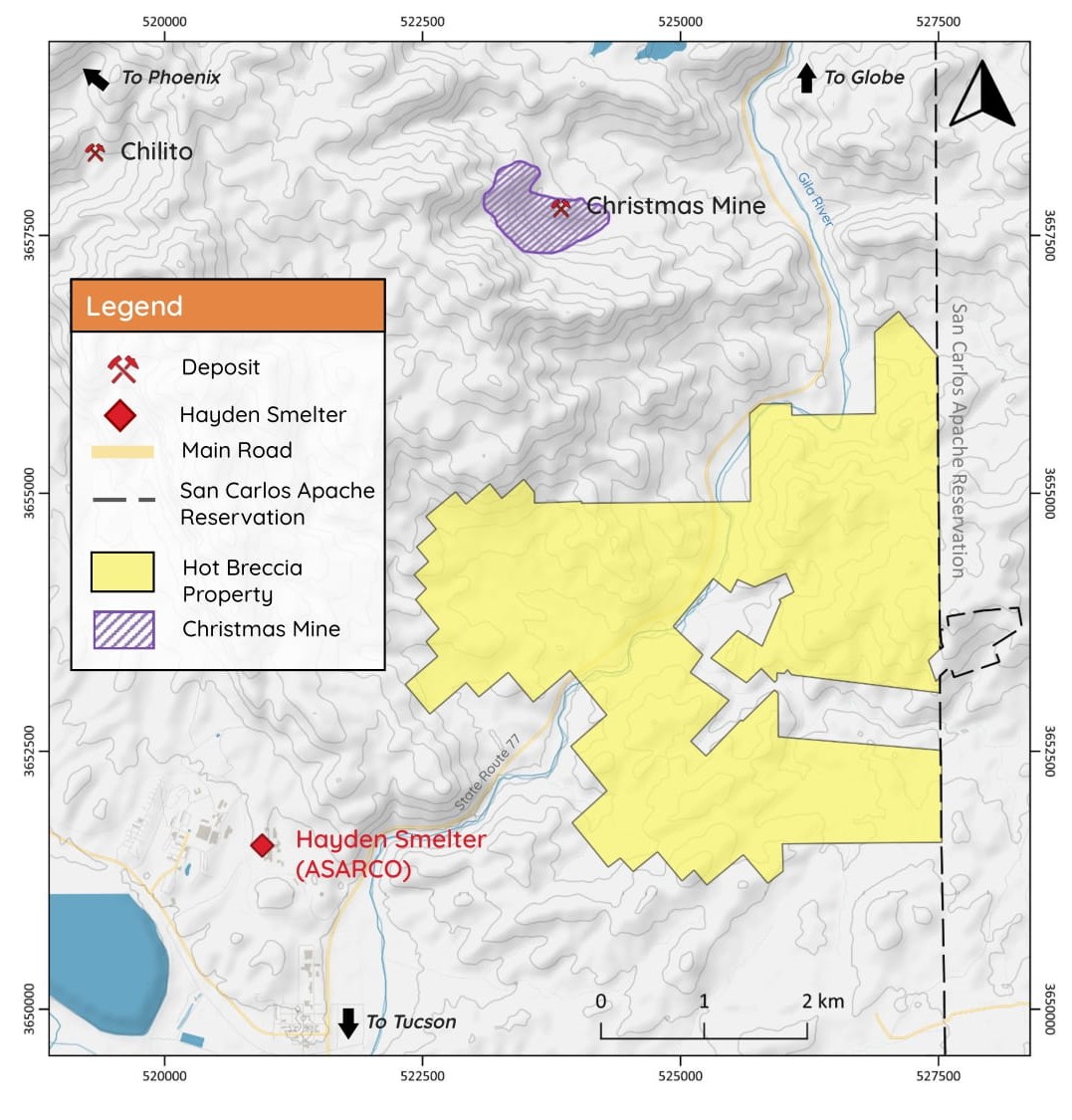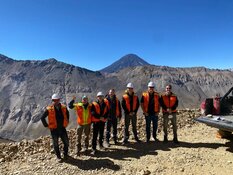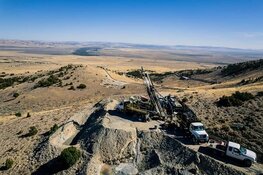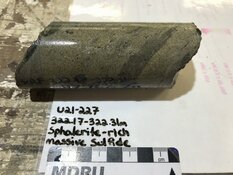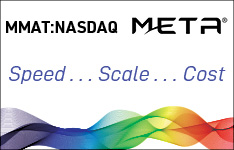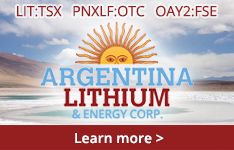The most accurate of the Wall Street "strategists" over the past year or so has been Bank of America CIO Michael Hartnett who, according to an article in Zerohedge this morning, has called the recent movements in the S&P 500 to a tee. Now, I do not follow his (or anyone else’s) prognostications about the stock market choosing instead to do my own work.
The reason for this choice is really quite simple: I would rather take credit for a blown call than try to blame someone else whose ideas you have been secretly plagiarizing for personal credit and glory.
With the Fed funds rate at 5%, interest expense alone is going to run somewhere around US$1.55 trillion.
While Hartnett’s quote shown above makes a great deal of sense, I am not entirely certain that he is going to be correct.
How many real bear markets associated with recessions have we experienced since 1981-1982? Each major 20% decline was punctuated by a Federal Reserve lifeline in the form of drastic rate reductions or stimulus or bailouts. 2001-2002 was terminated by aggressively easy monetary policy and a pre-orchestrated housing bubble.
The Great Financial Crisis of 2007-2008 was ended by a massive criminal bailout of the banks that caused the crisis. The Q1 2020 Covid Crash in stocks lasted a couple of months and constituted a 35% bear market decline that was rectified by a few trillion dollars in fiscal and monetary stimulus designed to offset the global depression that would have followed the global economic shutdown.
Debt
The bear market of 1981-1982 was caused by rampaging inflation rates being bludgeoned by soaring borrowing costs and only until Paul Volcker took his hobnail boot off the throat of the U.S. economy did stocks recover. The problem with trying to fabricate analogs to fit the current market environment lies in one very small word that is highlighted in the following quote:
"U.S. government debt to rise >US$21tn next ten years = US$5.2bn every day, US$218mn every hour . . . the great irony of inflationary 2020s will be in next recession Fed forced to resort to YCC to bail out the U.S. government . . . and that’s when the next great bull market in risk begins."
There surfaces that word again — DEBT — and all I ever need to do to snap my consciousness back to the stark reality of the 2023 world as we know it is to peruse my last dozen weekly missives. I am always revisiting that theme and whenever I do, I always default back to the necessity of owning gold as a surrogate for government bonds or bank paper.
The reason that I refute the idea that a steep recession will need to precede the next "great bull market" is based upon the total debt level of the U.S. government which was US$25 trillion in January 2020 when I wrote the Forecast Issue but which is estimated to be US$31 trillion today. With the Fed funds rate at 5%, interest expense alone is going to run somewhere around US$1.55 trillion.
Tax revenues estimated for 2023 are US$3.4 trillion so ex-interest the government nets about US$1.85 trillion. Now remove the 2023 military budget of US$800 billion and the U.S. is left with a tad over US$1 billion with which to cover expenditures which includes unfunded liabilities such as social security at US$2.7 trillion.
Furthermore, the probability of seeing tax receipts rise in any recession is analogous to the likelihood of Justin Trudeau taking a course in economics.
In other words, unless the next recession being invited with open arms by Fed Chairman Jerome Powell will see a US$2 trillion increase in tax receipts, there is a strong likelihood that "the next great bull market" in stocks will be somewhat delayed.
Furthermore, the probability of seeing tax receipts rise in any recession is analogous to the likelihood of Justin Trudeau taking a course in economics.
DEBT is still the operative impediment to growth around the world but to the average politician, debt is merely a temporary condition that can be legislated into a manageable irritation.
With nothing in the form of laws or leaders to deter the profligate spending habits of the ruling class elite, we find ourselves handing out billions of dollars to corrupt foreign regimes with which to defend themselves against aggressors whose interests are of a regional nature rather than the imperialist ambitions of those that would oppose them.
It is what happens after decades of deficit spending during which all respect for the sanctity of the domestic currency is abandoned in favor of votes first and legacy second.
I recognize that I may often do my rendition of the needle on a phonograph stuck on a section of an LP disk resulting in an annoying repetition that back in the day would result in a Frisbee competition. Unfortunately, people around the globe that are dumping gold producers, developers, and explorers are forgetting that of all the balance sheet assets held on the books of countries, states, provinces, corporations, religious organizations, private citizens, and hermits in the West Virginia mountains, the only one that I tangible is gold.
There exists no other asset on those books that represents collateral free from counterparty interference.
You think your life savings is "safe" in a bank?
Think twice. Bail-in legislation was passed in Canada over a decade ago and now your savings are part of that institution’s working capital.
I wrote about this in 2020 when I postulated about the price of gold required to fully collateralize the US$24 trillion worth of U.S. debt and started off with the 8,133 metric tonnes of gold held on behalf of the U.S. Treasury. Assuming that the gold still exists unencumbered by liens after all these years, it represents 286,802,112 ounces of gold.
I believe that in order to maintain its status as the world’s reserve currency . . . the U.S. is going to be forced to demonstrate to the world that is has the collateral to back up all claims against the dollar.
If that were to be repriced to fully cover the debt, gold would need to be revalued at US$83,680 per ounce. Even if it were to follow the mortgage lending rules for a minimum down payment required on a property at 10%, that would still put a value of US$8,360.
At today’s post-Covid debt total of somewhere north of US$31 trillion, the number balloons out to US$108,088 per ounce of gold.
Since gold resides today at US$1,818, it represents a total dollar value of US$521 billion being held by the U.S. central bank against US$31 trillion of debt. Total U.S. gold holdings represent 1.6% of the nation’s total debt. That seems woefully inadequate given the fact that since the Volcker era, the U.S. has gone from being the world’s largest creditor nation to the world’s largest debtor nation.
Where am I going with all of this anti-fiat rhetoric?
I believe that in order to maintain its status as the world’s reserve currency, especially in light of efforts to diversify by a growing number of countries, especially petroleum-exporting countries, the U.S. is going to be forced to demonstrate to the world that is has the collateral to back up all claims against the dollar in a manner far more convincing than, say, Russia or China.
By resetting the price of gold, they can affect such a demonstration and restore any and all doubt in the sanctity of the American dollar. It is, in my view, only a matter of time.
Agnico Eagle
Therefore, buying deeply-discounted gold producers like Agnico Eagle Mines Ltd. (AEM:TSX; AEM:NYSE) trading at 30 times earnings with a yield of 3.52% in anticipation of a revaluation of the product they have successfully produced for decades would seem like a really good, conservative strategy.
Agnico is only one example of a proven multinational resource company thrown under the bus by the new generation of professional investors who are far more comfortable with a tech stock with a good story and no cash flow than companies with decades of performance history.
I believe this all changes by the end of 2023.
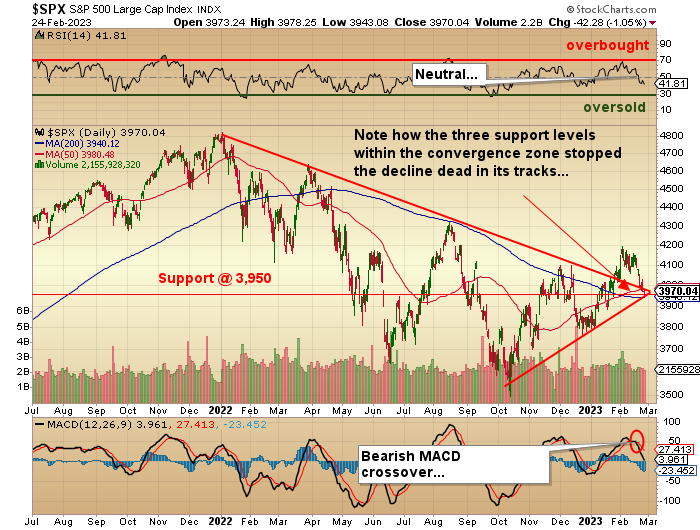
Stocks ended the week on a down note closing slightly below the 50-dma (3,980) but still above the 200-dma (3,940) and the uptrend line drawn off the October and December lows. Upside potential is still hampered by the sell signal thrown off by the Bearish MACD crossover from early February. With an RSI of 41, the downside is limited.
Subscribers took profits on the SPY March US$410 puts bought on the second and fourth of the month and are awaiting either a) a two-day close below 3,950 (which targets the December lows at 3,783) or b) heads back up to 4,100-4,200. The stance I am taking is "sell rallies above 4,100" because the battle between improving sentiment and deteriorating fundamentals is causing a great deal of collateral damage.
I do not see a break below the December lows but would like to see a move to 3,850 accompanied by a sub-30 RSI at which point I will reload those positions from last October that were jettisoned in mid-January.
One thing is a certainty: this is one miserably-difficult market with liquidity abandoning the junior explorer/developer space; with gold and silver being treated like carriers of the Bubonic Plague; and with the broad markets confusing even the savviest of pros.
Gold
Gold is now rapidly approaching oversold status with the RSI for the gold ETF proxy SPDR Gold Shares ETF (GLD:NYSE) now at a paltry 32.
Still working on the Bearish MACD crossover from early February, I would love to see a final capitulation spike down to US$1,775 with a sub-25 RSI and rising volume.
I am looking to get very long if that happens because relative to stocks and other asset classes, gold is cheap as well as most of the gold equities that produce, develop, or explore for the yellow metal.
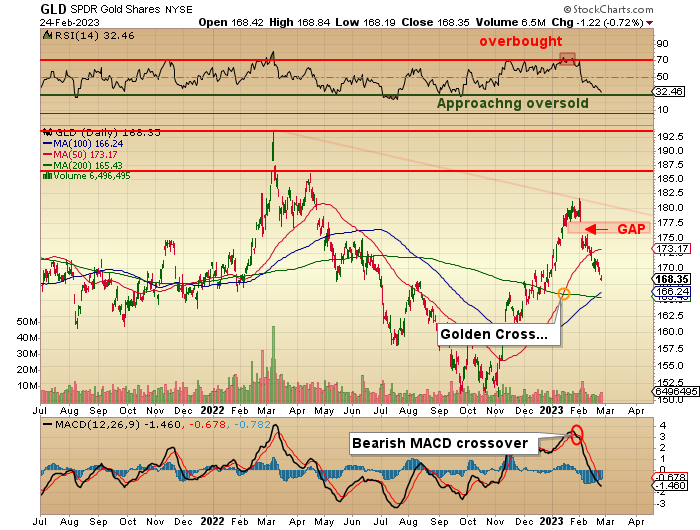
Allied Copper
Top-ranked Allied Copper Corp. (CPR:TSX.V; CPRRF:OTCQB) announced the closing of their upsized private placement unit offering wherein they raised a very impressive CA$4 million (versus the original CA$2m first announced) which will accelerate the completion of the pilot plant operation as well as tighten up the milestones shown in the corporate presentation.
What caught my attention was this statement:
"Officers and directors of the Company including Alex Wylie, Kyle Hookey, Marty Scase, Warner Uhl, and Morgan Tiernan participated in the private placement and acquired 1,647,755 units for $329,551."
There is nothing I like seeing in any deal more than the Chairman (Uhl), the President (Wylie), Interim CEO (Hookey), and a Director (Scase) acquiring positions alongside their shareholders and reporting it.
This is the ultimate in "Skin in the Game" which I have written for years as it provides enormous confidence in management when they are writing the same cheques as we are.
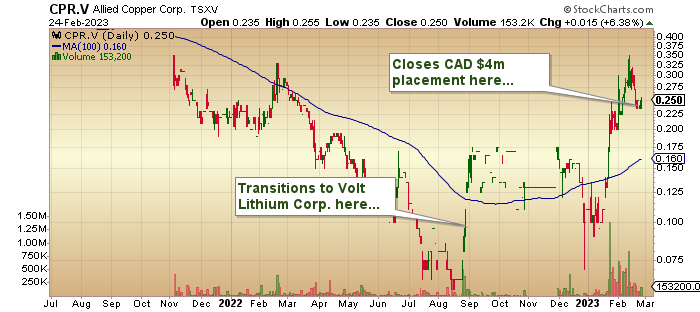
Also noteworthy is that the company will have the name change put into effect next week as it makes the transition to Volt Lithium Corp. and will announce a revised listing symbol and CUSIP numbers in due course.
This deal has moved into the "Must Own" category and continues to impress me with its flawless execution and timing.
Want to be the first to know about interesting Gold and Base Metals investment ideas? Sign up to receive the FREE Streetwise Reports' newsletter.
Subscribe
Michael Ballanger Disclaimer:
This letter makes no guarantee or warranty on the accuracy or completeness of the data provided. Nothing contained herein is intended or shall be deemed to be investment advice, implied or otherwise. This letter represents my views and replicates trades that I am making but nothing more than that. Always consult your registered advisor to assist you with your investments. I accept no liability for any loss arising from the use of the data contained on this letter. Options and junior mining stocks contain a high level of risk that may result in the loss of part or all invested capital and therefore are suitable for experienced and professional investors and traders only. One should be familiar with the risks involved in junior mining and options trading and we recommend consulting a financial adviser if you feel you do not understand the risks involved.
Disclosures:
1) Michael J. Ballanger: I, or members of my immediate household or family, own securities of the following companies mentioned in this article: Allied Copper Corp. I personally am, or members of my immediate household or family are, paid by the following companies mentioned in this article: My company, Bonaventure Explorations Ltd., has a consulting relationship with: None.
2) The following companies mentioned in this article are billboard sponsors of Streetwise Reports: None. Click here for important disclosures about sponsor fees. As of the date of this article, an affiliate of Streetwise Reports has a consulting relationship with: None. Please click here for more information.
3) Statements and opinions expressed are the opinions of the author and not of Streetwise Reports or its officers. The author is wholly responsible for the validity of the statements. The author was not paid by Streetwise Reports for this article. Streetwise Reports was not paid by the author to publish or syndicate this article. Streetwise Reports requires contributing authors to disclose any shareholdings in, or economic relationships with, companies that they write about. Streetwise Reports relies upon the authors to accurately provide this information and Streetwise Reports has no means of verifying its accuracy.
4) This article does not constitute investment advice. Each reader is encouraged to consult with his or her individual financial professional and any action a reader takes as a result of information presented here is his or her own responsibility. By opening this page, each reader accepts and agrees to Streetwise Reports' terms of use and full legal disclaimer. This article is not a solicitation for investment. Streetwise Reports does not render general or specific investment advice and the information on Streetwise Reports should not be considered a recommendation to buy or sell any security. Streetwise Reports does not endorse or recommend the business, products, services or securities of any company mentioned on Streetwise Reports.
5) From time to time, Streetwise Reports LLC and its directors, officers, employees or members of their families, as well as persons interviewed for articles and interviews on the site, may have a long or short position in securities mentioned. Directors, officers, employees or members of their immediate families are prohibited from making purchases and/or sales of those securities in the open market or otherwise from the time of the decision to publish an article until three business days after the publication of the article. The foregoing prohibition does not apply to articles that in substance only restate previously published company releases. As of the date of this interview, officers and/or employees of Streetwise Reports LLC (including members of their household) own securities of Agnico Eagle Mines Ltd. and Allied Copper Corp., companies mentioned in this article.



